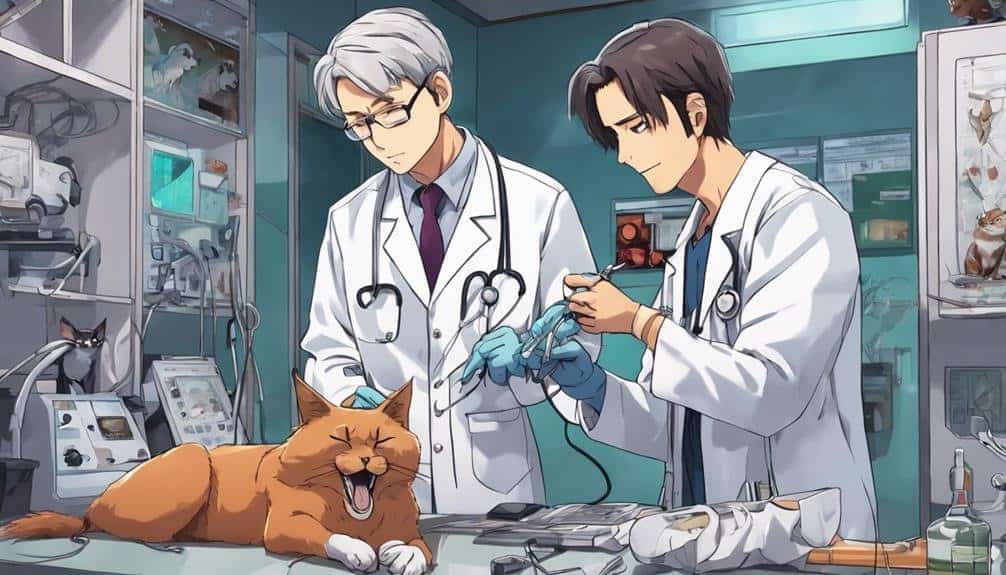Job Duties for Veterinarian
Being a veterinarian entails a multifaceted role that goes beyond just treating animals. From conducting thorough medical examinations to performing intricate surgical procedures, the job duties are vast and varied.
However, there is an important aspect of the profession that often goes unnoticed but is equally significant – client consultations and communication. The ability to effectively communicate with pet owners is not only essential for providing proper care but also for building trust and understanding.
This important component of a veterinarian's job highlights the importance of empathy, clear communication, and the delicate balance between medical expertise and emotional support.
Key Takeaways
- Conduct thorough medical examinations and detailed physical assessments for accurate diagnoses.
- Personalize treatment plans, educate pet owners, and collaborate for effective care.
- Perform common surgical procedures with tailored anesthetic protocols and provide post-operative care.
- Utilize imaging and diagnostic tools like X-rays, MRI, and ultrasound for precise evaluations and treatments.
Medical Examinations and Assessments
In the role of a veterinarian, conducting thorough medical examinations and assessments forms the cornerstone of providing quality care for animal patients. Patient handling and effective client communication are essential skills that aid in gathering important information to assist in diagnosing and treating various health conditions. A veterinarian's ability to perform detailed physical examinations and obtain a thorough medical history is paramount in identifying underlying issues and developing appropriate treatment plans.
During patient examinations, veterinarians meticulously evaluate vital signs, body condition, and specific symptoms to pinpoint areas of concern. By engaging with clients, veterinarians can gather valuable insights into the animal's behavior, diet, and environment, which can offer crucial clues for diagnosis. Effective communication with pet owners is key to ensuring a complete understanding of the animal's health status and fostering trust and compliance with recommended treatment protocols.
Treatment Planning and Implementation
Developing thorough treatment plans tailored to each animal's unique needs is a critical aspect of a veterinarian's role in ensuring the best health outcomes. This process involves evaluating the animal's condition, considering various treatment options, and collaborating with the pet owner to determine the most effective course of action. To achieve treatment planning efficiency and positive patient outcomes, veterinarians should:
- Personalize Treatment Plans: Tailoring treatments to the specific needs of each animal can lead to better outcomes and improved quality of life.
- Implement New Therapies: Staying current with advancements in veterinary medicine enables veterinarians to offer cutting-edge treatments that may enhance recovery and overall wellness.
- Provide Client Education: Educating pet owners about the treatment plan, including medication administration, at-home care, and potential side effects, fosters better understanding and compliance, ultimately benefiting the animal's health.
Surgical Procedures and Operations
When it comes to performing surgical procedures as a veterinarian, it is essential to be well-versed in common surgical techniques. This includes procedures such as spaying and neutering, tumor removals, and orthopedic surgeries.
Anesthetic protocols tailored to each patient's needs play an important role in ensuring a safe and successful surgical outcome. Proper administration and monitoring of anesthesia are critical during the procedure to minimize risks and complications.
Additionally, providing thorough post-operative care instructions to pet owners is necessary for promoting proper healing and minimizing complications. Clear guidance on wound care, medication administration, activity restrictions, and follow-up appointments is crucial for the pet's recovery and overall well-being.
Common Surgical Procedures
Performing a variety of common surgical procedures is an important aspect of a veterinarian's role in providing thorough care for animals. When conducting surgeries, veterinarians must guarantee proper post-surgery rehabilitation and pain management to aid in the animal's recovery. Additionally, utilizing effective sterilization techniques is vital to prevent infections post-operation. Proper wound care is essential to promote healing and reduce the risk of complications.
Here are some common surgical procedures that veterinarians often perform:
- Spaying or neutering surgeries to prevent overpopulation and improve the animal's health.
- Soft tissue surgeries such as tumor removals or wound repairs.
- Orthopedic surgeries to address bone fractures or joint issues in animals.
Anesthetic Protocols for Surgery
Ensuring precise and tailored anesthetic protocols is a foundational component of executing successful surgical procedures for animals as a veterinarian. Pain management and monitoring are critical during surgery to guarantee the comfort and safety of the patient. Patient recovery protocols post-surgery play a vital role in the overall success of the procedure. By carefully selecting the appropriate anesthetic agents and constantly monitoring the patient's key signs, veterinarians can greatly reduce risks associated with anesthesia.
| Anesthetic Protocols for Surgery |
|---|
| 1. Select appropriate anesthetic agents based on patient's health status. |
| 2. Monitor key signs throughout the procedure. |
| 3. Adjust anesthesia levels as needed for the best pain management. |
| 4. Implement patient recovery protocols to guarantee a smooth post-operative experience. |
Post-Operative Care Instructions
For optimal recovery following surgical procedures and operations, meticulous post-operative care instructions are vital to guarantee the well-being and comfort of the animal patients.
Post-Operative Care Instructions:
- Recovery Monitoring and Pain Management:
- Monitor the animal closely post-surgery for any signs of distress or complications.
- Administer prescribed pain medications as directed and observe for any adverse reactions.
- Follow-Up Care:
- Schedule follow-up appointments to assess healing progress and remove sutures if necessary.
- Make sure the animal is eating, drinking, and moving comfortably.
- Wound Care:
- Keep the surgical site clean and dry.
- Follow specific wound care instructions provided, including changing dressings and applying any prescribed ointments.
- Watch for signs of infection such as redness, swelling, or discharge.
Diagnostic Testing and Interpretation
As a veterinarian, the ability to analyze test results accurately is paramount in diagnosing and treating animals effectively. Proficiency in interpreting various imaging modalities, such as X-rays and ultrasounds, is essential for identifying underlying health issues.
Additionally, having a strong command of diagnostic tools, like blood tests and urinalysis, aids in providing thorough care to our furry patients.
Test Result Analysis
Analyzing diagnostic test results is a critical aspect of a veterinarian's role, requiring a meticulous approach to interpretation and decision-making. When it comes to test result analysis, veterinarians must guarantee accuracy and precision in their assessments.
This involves thorough data analysis to draw conclusions and make informed decisions about the health of the animal. Additionally, performance evaluation is vital in determining the effectiveness of diagnostic tests and the quality of results obtained.
Quality assurance processes should be in place to maintain high standards in test result analysis and interpretation, ensuring that the best possible care is provided to the animals under their supervision.
Imaging Interpretation Skills
In the domain of veterinary medicine, adept imaging interpretation skills play a pivotal role in the thorough diagnostic testing and interpretation process. Veterinarians with radiology expertise can accurately analyze X-rays, MRIs, and CT scans to diagnose various conditions in animals. Case studies are often used to enhance learning and improve skills in interpreting complex imaging results. Additionally, proficiency in ultrasound interpretation is valuable for diagnosing soft tissue injuries, pregnancies, and more. Continuous training opportunities in imaging interpretation help veterinarians stay updated with the latest technologies and techniques, ensuring high-quality care for their animal patients.
| Imaging Modality | Importance | Examples |
|---|---|---|
| X-rays | Common diagnostic tool | Fractures, lung issues |
| MRI | Detailed soft tissue view | Brain abnormalities |
| Ultrasound | Real-time imaging | Heart function, pregnancies |
Diagnostic Tool Proficiency
Proficiency in utilizing a diverse range of diagnostic tools is essential for veterinarians to accurately assess and interpret medical conditions in animal patients. To excel in this aspect, veterinarians must focus on:
- Equipment maintenance, training: Regular maintenance of diagnostic equipment is critical to guarantee accurate results. Veterinarians should also undergo continuous training to stay updated on the latest advancements in diagnostic tools.
- Research advancements, challenges: Staying informed about research advancements in diagnostic tools is essential for providing the best care to animal patients. However, veterinarians must also be prepared to navigate challenges such as access to specialized equipment or interpreting complex test results accurately.
Vaccinations and Preventive Care
When it comes to providing thorough care for animals, vaccinations and preventive measures play an essential role in maintaining their health and well-being. Preventive measures such as regular vaccinations are vital in safeguarding animals against various diseases. Veterinarians follow specific vaccine protocols tailored to the individual needs of each animal, taking into account factors like species, age, lifestyle, and risk factors. By staying up-to-date with the latest research and guidelines, veterinarians make sure that they are offering the most effective and safe preventive care to their animal patients.
In addition to administering vaccines, veterinarians educate pet owners on the importance of preventive care and the role vaccinations play in promoting overall health. They discuss the significance of annual wellness exams, parasite prevention, and proper nutrition, all of which contribute to a pet's well-being. Through proactive measures and open communication with pet owners, veterinarians aim to prevent illnesses and keep animals healthy throughout their lives.
Client Consultations and Communication
Effective client consultations and clear communication are integral components of a veterinarian's practice, ensuring peak care for animal patients.
- Client Education and Communication: Veterinarians must effectively communicate with pet owners, providing clear information about their pet's condition, treatment options, and preventive care measures. Educating clients about proper animal care empowers them to make informed decisions regarding their pet's well-being.
- Building Client Relationships: Developing strong relationships with clients is essential in veterinary medicine. By fostering trust and open communication, veterinarians can create a supportive environment where clients feel comfortable discussing their concerns and following medical recommendations.
- Establishing Trust: Transparent communication builds trust between veterinarians and clients. Being honest about treatment plans, costs, and expected outcomes helps establish credibility and ensures that clients feel confident in the care their pets receive. Trust is the foundation of a successful veterinary practice, leading to better compliance with medical advice and improved patient outcomes.
Emergency Response and Critical Care
In the fast-paced and unpredictable domain of veterinary medicine, the ability to swiftly and decisively respond to emergencies and provide thorough care is paramount for ensuring the well-being of animal patients. Veterinarians undergo rigorous emergency response training to prepare for a wide range of critical situations they may encounter in their practice. From administering life-saving treatments to stabilizing injured animals, these professionals must adhere to established thorough care protocols to optimize patient outcomes.
Emergency response training equips veterinarians with the necessary skills to handle traumatic injuries, toxicities, and sudden illnesses with precision and efficiency. They must be adept at triaging cases based on the severity of the condition, prioritizing interventions accordingly. Additionally, veterinarians are trained to collaborate seamlessly with veterinary technicians and support staff in high-pressure scenarios to deliver thorough care to each patient.
Record-Keeping and Documentation
Demonstrating meticulous attention to detail, veterinarians are responsible for maintaining accurate record-keeping and documentation to ensure thorough care for their animal patients. This aspect of their job is essential for guaranteeing the well-being of animals under their supervision.
In the domain of record-keeping and documentation, veterinarians focus on the following key areas:
- Compliance Monitoring: Veterinarians must adhere to strict regulations and guidelines to ensure that their practices are compliant with legal requirements. This includes accurately documenting treatments, medications administered, and patient history to meet industry standards.
- Quality Assurance: Maintaining high-quality records is vital for providing the best possible care to animal patients. Quality assurance measures involve regularly reviewing documentation practices to identify areas for improvement and ensure that all information is up-to-date and accurate.
- Electronic Health Records, Telemedicine Integration: Embracing technological advancements, veterinarians are increasingly utilizing electronic health records and integrating telemedicine into their practices. This allows for efficient record-keeping, seamless communication, and improved access to patient information, ultimately enhancing the level of care provided to animals.
Continuing Education and Professional Development
To stay current in the ever-evolving field of veterinary medicine, veterinarians prioritize continuing education and professional development to enhance their knowledge and skills. This ongoing learning process is essential for staying abreast of the latest advancements, techniques, and treatments in animal healthcare. Veterinarians often engage in a variety of activities to fulfill their continuing education requirements, such as online courses and seminars.
These virtual learning opportunities allow them to explore specific topics of interest conveniently from their practice or home. Additionally, industry conferences and workshops provide valuable networking opportunities and hands-on experiences with the latest technologies and procedures. By attending these events, veterinarians can interact with peers, learn from experts in the field, and gain practical skills that they can implement in their daily practice.
Conclusion
To sum up, veterinarians play a vital role in providing medical care to animals through medical examinations, treatment planning, surgical procedures, and diagnostic testing. They also focus on preventive care, client communication, emergency response, and record-keeping.
Continuing education is essential for veterinarians to stay updated on the latest advancements in veterinary medicine. According to the Bureau of Labor Statistics, the employment of veterinarians is projected to grow by 16% from 2020 to 2030, much faster than the average for all occupations.







